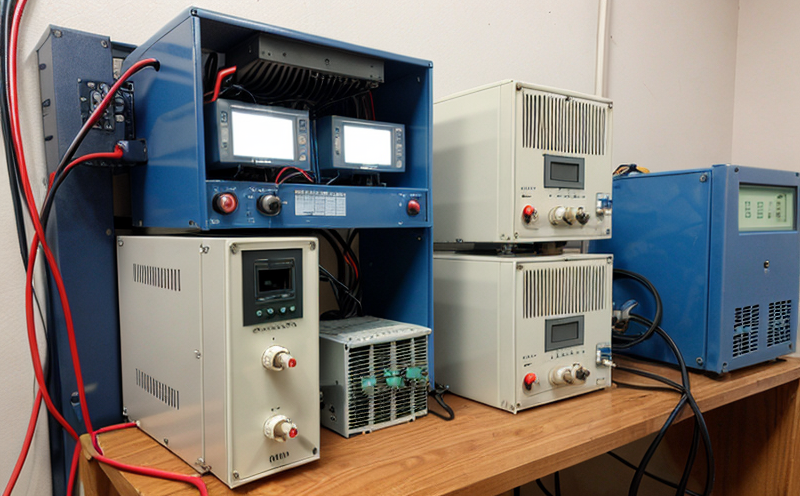EN 50328 Testing of Railway Rectifiers
The European Standard EN 50328 provides a comprehensive framework for testing railway rectifiers, ensuring that they meet stringent performance and safety requirements. This standard is pivotal in the railway sector as it guarantees the reliability and safety of power supply systems in rail transportation.
EN 50328 covers various aspects of railway rectifier testing including electrical performance, mechanical robustness, thermal stability, and electromagnetic compatibility (EMC). The scope encompasses both the static and dynamic characteristics of rectifiers used in railway applications. This ensures that the devices can operate reliably under all expected environmental conditions and operational scenarios.
The standard is designed to ensure that rectifiers comply with international safety standards such as IEC 61508, which sets out functional safety requirements for electrical/electronic/programmable electronic safety-related systems. By adhering to EN 50328 and other relevant standards like EN 50497-3, railway operators can ensure that their power supply systems are robust and safe.
The testing process involves several key steps. Initially, the rectifier is subjected to a series of electrical stress tests to evaluate its ability to withstand overvoltage conditions without damage or degradation. This includes load cycling tests to simulate real-world operational stresses. The rectifiers must also pass thermal stress tests to ensure they can operate efficiently under high heat loads.
EMC testing is another critical aspect, ensuring that the rectifier does not interfere with other electrical systems on the railway and is immune from interference itself. This includes emissions and immunity tests at different frequency bands relevant to railway applications.
In addition to these electrical tests, mechanical robustness checks are conducted to ensure the rectifier can withstand physical shocks and vibrations typical of rail environments. Environmental testing may also be required to confirm performance in extreme temperature ranges or humidity levels that could affect reliability.
The test results from EN 50328 compliance are crucial for quality managers, ensuring that procurement decisions meet safety and operational requirements. Compliance with this standard is mandatory for rectifiers intended for use on European railways, making it a cornerstone of railway infrastructure.
- Compliance ensures the safety and reliability of power supply systems in rail transportation.
- It supports international standards like IEC 61508 for functional safety requirements.
- The standard covers electrical performance, mechanical robustness, thermal stability, and EMC.
- Tests include load cycling, overvoltage stress, thermal stress, and electromagnetic compatibility checks.
Applied Standards
The EN 50328 standard is widely recognized for its detailed specifications on the testing of railway rectifiers. It complements other international standards such as IEC 61508, which focuses on functional safety requirements, and EN 50497-3, which addresses power quality in railway systems.
EN 50328 ensures that the tested rectifiers can operate reliably under various conditions encountered in real-world rail environments. This includes high ambient temperatures, frequent switching between different loads, and exposure to electromagnetic interference (EMI). The standard also emphasizes the importance of testing for both static and dynamic performance characteristics.
The use of EN 50328 is mandatory for rectifiers intended for installation on European railways. Compliance with this standard not only ensures safety but also supports interoperability between different railway systems across Europe. This is particularly important given the increasing integration and connectivity of rail networks in the region.
Competitive Advantage and Market Impact
- Compliance with EN 50328 enhances a manufacturer's reputation for reliability and safety.
- It facilitates market access to European railways, ensuring interoperability across different systems.
- The standard supports the functional safety requirements outlined in IEC 61508.
- Compliance helps avoid costly recalls and product rejections due to non-compliance with regulatory standards.
Meeting EN 50328 specifications can give a company a competitive edge by ensuring its products meet the stringent requirements set forth by European railway authorities. This standard is not only mandatory for rail applications but also serves as a benchmark for quality and safety in the industry.
In terms of market impact, compliance with EN 50328 can open doors to lucrative contracts and partnerships within the European Union's railway sector. It demonstrates a commitment to adhering to international standards, which is increasingly important in an interconnected global marketplace.
Use Cases and Application Examples
The EN 50328 standard finds extensive application across various railway systems within the European Union. It is particularly relevant for rectifiers used in traction power supply, auxiliary power units (APUs), and other critical electrical components that ensure reliable operation of trains.
For instance, a rectifier tested against EN 50328 would be suitable for integration into an electrified railway infrastructure. The standard ensures that the rectifier can handle the dynamic load changes typical of train operations, including acceleration and deceleration phases. This is crucial for maintaining stable power supply to traction motors and other onboard electrical systems.
In addition to traction applications, EN 50328 compliant rectifiers are also used in auxiliary power units that provide electricity for lighting, air conditioning, and other essential services on trains. The standard ensures these components can operate efficiently under varying environmental conditions, further enhancing the overall performance of railway systems.
Furthermore, compliance with EN 50328 is a prerequisite for any rectifier intended for use in signaling and communication systems within railway environments. These systems require reliable power supply to function correctly, and adherence to this standard ensures that the rectifiers meet the necessary safety and performance criteria.





